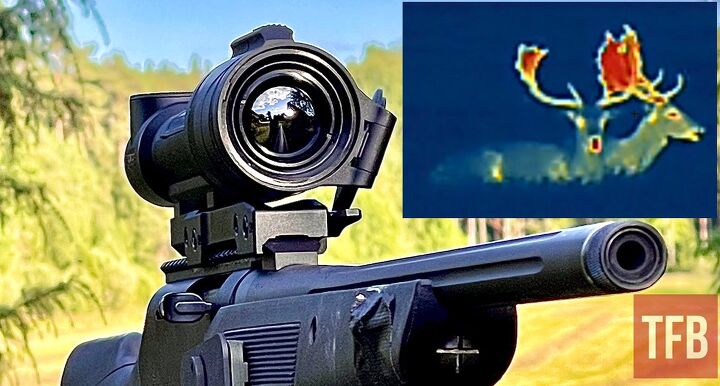This is a review of the Talion XQ38, Pulsar’s brand new Thermal Imaging Riflescope. Launched at SHOT Show 2022, it’s a compact, lightweight thermal imaging hunting riflescope with several advanced capabilities. The compact size and low weight in combination with a lean price point for a thermal sight make it stand out. It’s loaded with features that would work well on a number of hunting platforms, including ARs, semi-autos and bolt-action rifles. Wе had our sample for testing for a few months now and it’s time to wrap things up and tell our readers what we think about it.
Pulsar Vision @ TFB:
- TFB Review: Pulsar Thermion 2 LRF XP50 Pro Thermal Riflescope
- Pulsar Digex C50 – Digital Day & Night Vision Riflescope
- Pulsar Proton FXQ30 – Thermal Clip-On with Color Display
- Pulsar KRYPTON FXG50 – The Ultimate Thermal Vision Front Attachment?
- Pulsar Trail 2 LRF XP50 Thermal Imaging Riflescope
Below: Benelli MR1 in .223 Remington with the Pulsar Talion XQ38. It’s getting dark…
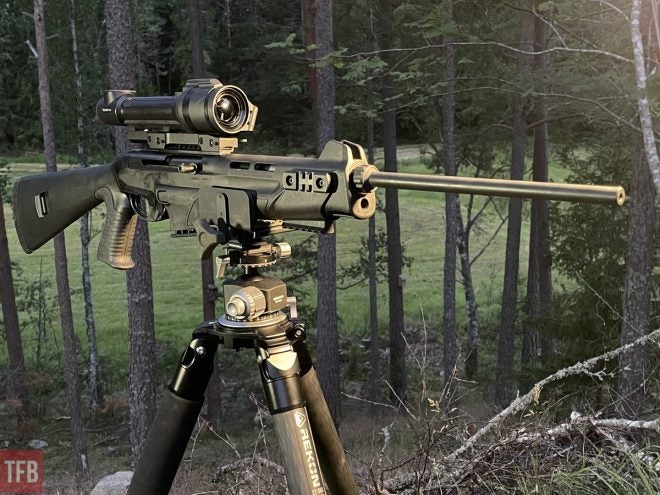
First Impressions and Ergonomics
When you get the Pulsar Talion in your hands, the first impression is that it’s very sleek and with no obvious moving parts. You can of course turn the ocular to get a good image from the screen, you can open a hidden battery compartment and you can change the focus ring. Apart from the blue on and off button, all controls are placed on the top panel of the eyepiece, with a hidden scroll wheel. This works well in many aspects. It’s convenient for both right- and left-handed users and you have the controls close to your eyes. I wish future Pulsar riflescopes all get this feature, as it’s better than the scroll wheel on the Thermion for instance.
In the picture below, note the “shark fin” focus ring at the front. When the protruding ridge is aligned, you have a focus at 70 m (76 yards), a pretty normal night-time shooting distance. This way you can focus your image without looking at the riflescope.
Below: The Pulsar Talion XQ38 mounted on a Browning BAR Match .308 Win. The housing is waterproof IPX7.
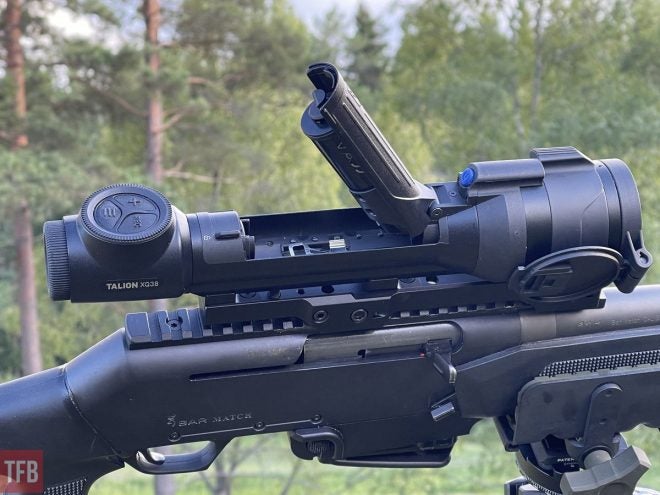
Remove the Schmidt & Bender 1.5-8x42mm STRATOS Hunting Rifle Scope and replace it with the Pulsar Talion XQ38 for thermal hunting. The picture is mainly to show you how compact the Pulsar is, only 330x57x67 mm (12.99” x 2.24” x 2.645”).

Overall, the Talion feels very robust and well-built. You don’t really get the impression that anything would break easily. All of the controls are rubberized and have a good tactile feel. The Talion is made of magnesium alloy and the total weight is 0.7 kg. The firmware was extremely stable.
Technical Specifications
The thermal sensor is made by Lyndred in France and has 384×288 pixels @ 17 µm, 50 Hz frame rate. The NETD is <40 mK (the lower the better). Note that a lot of manufacturers “forget” to specify their NETD values, but it’s a very important aspect of the image quality. The objective lens is F38 F/1.2 with a magnification between 2.5 − 10 (x4 zoom). The detection range is said to be 1350 meters. The field of view is almost 10° at 100 meters and eye relief is set at 50 mm. The screen you will be looking at is 1024х768 pixels AMOLED.
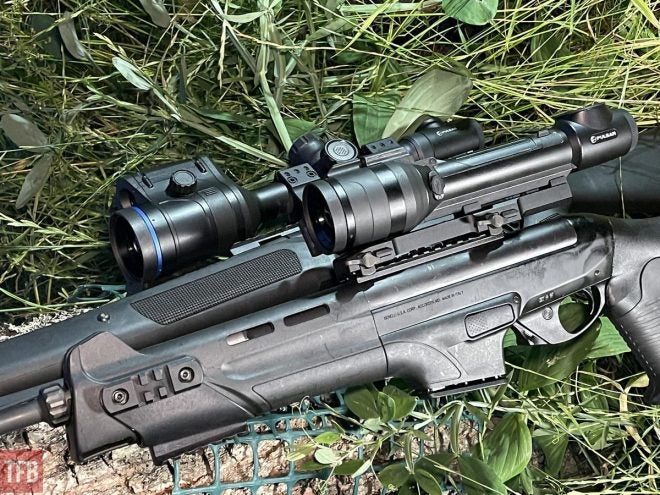
Image Quality
Image quality is probably the most important feature of any sight. If you’re new to thermals, or upgrading, you’ll probably love the performance. When you start it up, you’ll have a thermal image within a few seconds. While you get a respectable quality from the Talion XQ38 you cannot expect the same performance as from Talion’s bigger brother Thermion 2. Thermal sensors are expensive and the price difference (almost two times for some models) must show somewhere.
Don’t get me wrong, the Talion performs well considering its price and over the years I have become somewhat of a snob. It would conclude that, at its price point, the Talion XQ38 is probably one of the best, if not the best. But I don’t have access to all brands and models on the market, so I can only make an educated guess.
Images may tell a better story than my words. The main difference here is the quality of the thermal sensor and lens as well as the NETD value.
Below: Pulsar Talion XQ38 (2.5 base magnification. With some tweaking the background would probably come out much better).

Below: Pulsar Thermion 2 LRF XP50 Pro. (2x base magnification, for a wider field of view. Notice the finer details.)
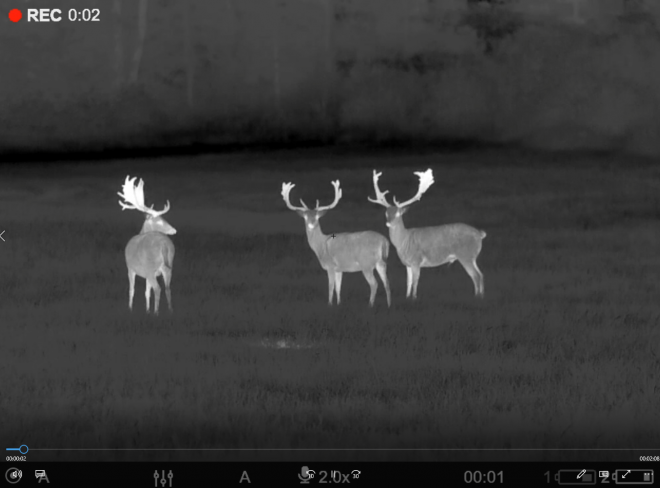
It’s difficult to describe image quality in words. These videos were recorded within minutes from each other with the same animals, place, conditions, etc. so you can make up your own mind. Remember that there is usually a (slight) quality loss from what you would see in the ocular versus in these videos.
Pulsar Talion XQ38 – Fallow Deer
Pulsar Thermion 2 LRF XP50 Pro – Fallow Deer
Below: Pulsar Thermion 2 LRF XP50 Pro (right) and Talion XQ38.
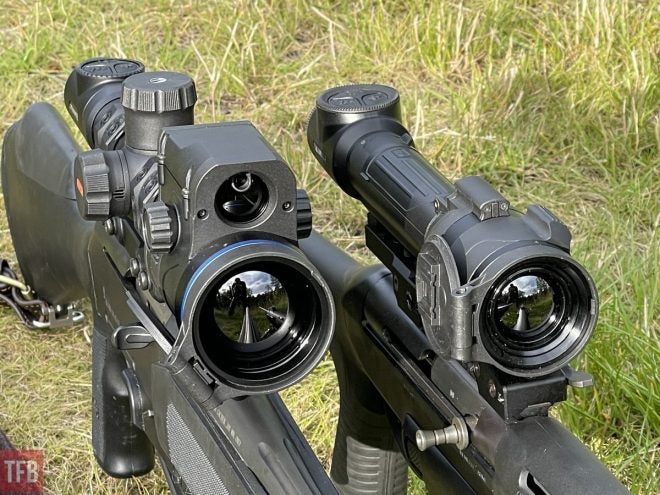
For reference, since I know many people ask about this, the Pulsar Thermion 2 XQ38 (not pictured anywhere here) has a slightly better image as its front lens is 35 mm while the Talion has 32 mm.
Long-Range Hunting?
I’m not a long-range hunter, even in daylight. I’m very careful, and much more so at night time. So don’t expect me to write that you should hunt foxes, coyotes and hogs at 200+ meters. It’s certainly possible with the Talion, but you will have some challenges with identification so make sure you know your surroundings and target. It does have some problems in humid conditions, but it’s to be expected.

Below are some sample still images.
Below: Roe buck at around 250-280 meters with some fog. As I mentioned, this is not a shot I would take.

And roughly 120-150 meters. The reticle is black here, not optimal but can be changed to a multitude of colors and combinations if you like.
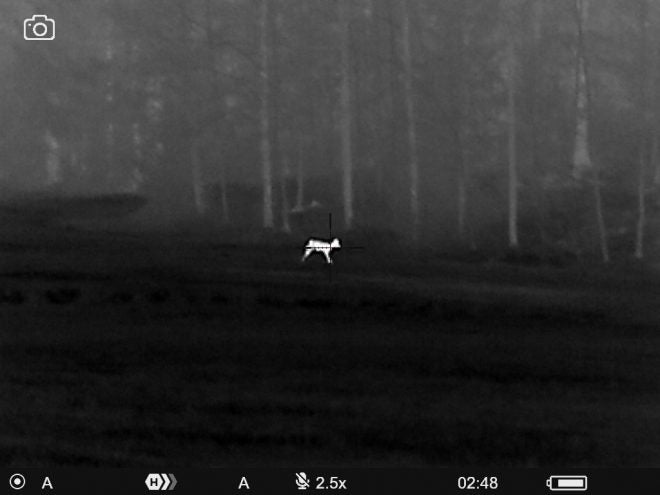
Horses, close.

Fallow deer, about 40 meters. You can change the settings so that you get a better overview of the surrounding forest and field if you like.
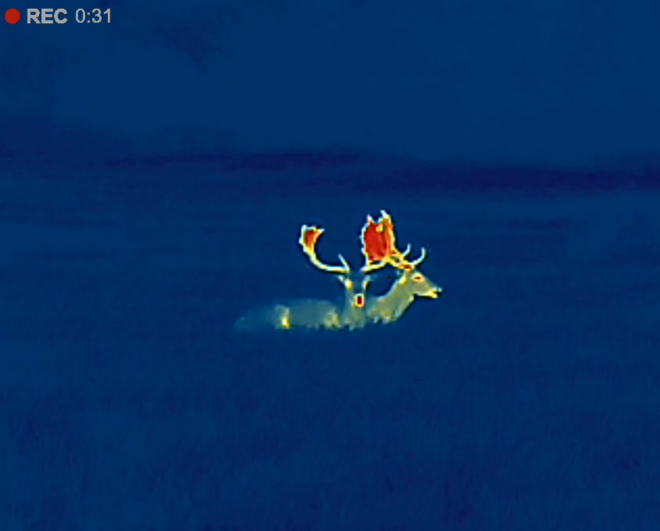
Fallow deer again, white hot, with the Picture in Picture function and the tiniest reticle available. The deer to the left had a pretty bad wound on its right leg.
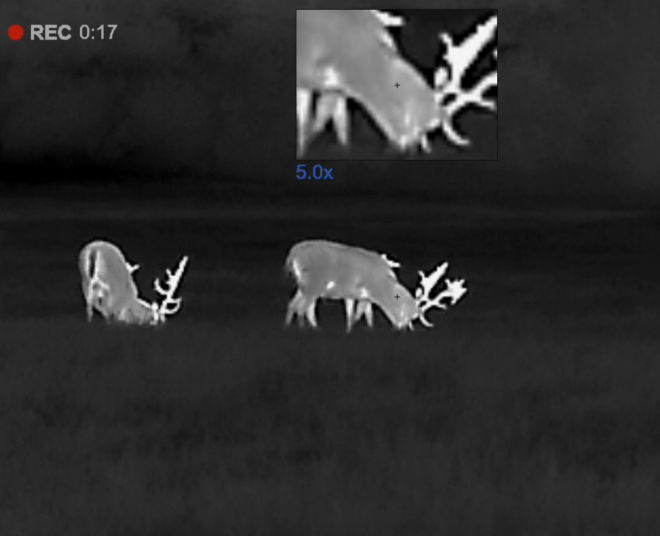
A badger at around 120 meters (I had an LRF besides).

Below: Wild boar sow with piglets. It’s easier when looking onto the screen or the video, but it was easy to see the pulled teats at close range. If you want to increase that distance, you need to get a more powerful thermal. In many countries in Europe, it’s forbidden to hunt sows with piglets, so this is an important feature in a thermal riflescope for a lot of hunters. A low NETD value will help here.
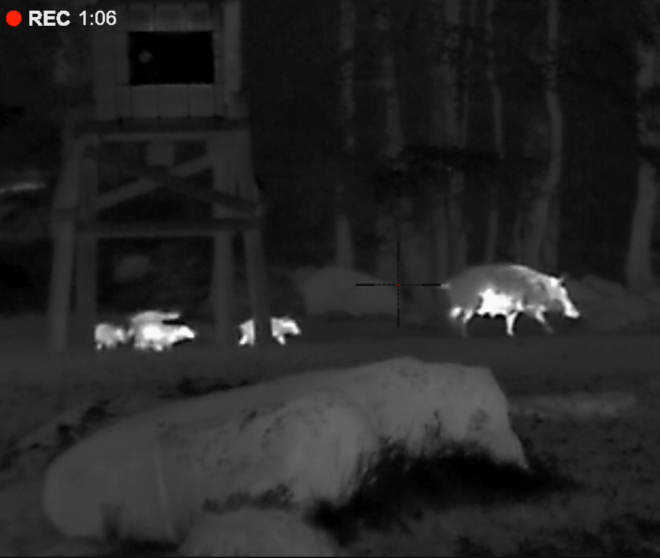
Using The Pulsar Talion In The Dark
I had no issues really, everything worked as expected. The battery compartment has a tight fit, but not a major issue. There are just a few buttons, and it’s easy to get to know them and what they do.

Below: The battery compartment of the Talion is open, for an easy change of the Pulsar APS5 rechargeable battery with 4900 mAh. There’s no internal battery. Pulsar claims up to 9 hours of battery life, and you could use an external power source if you like.

Right and left side view.

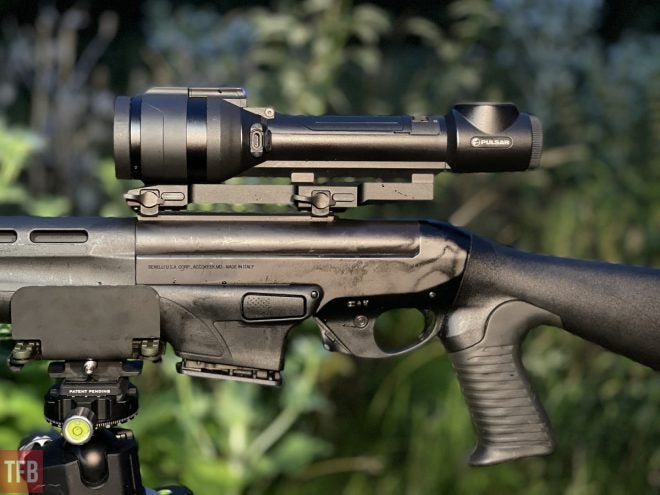
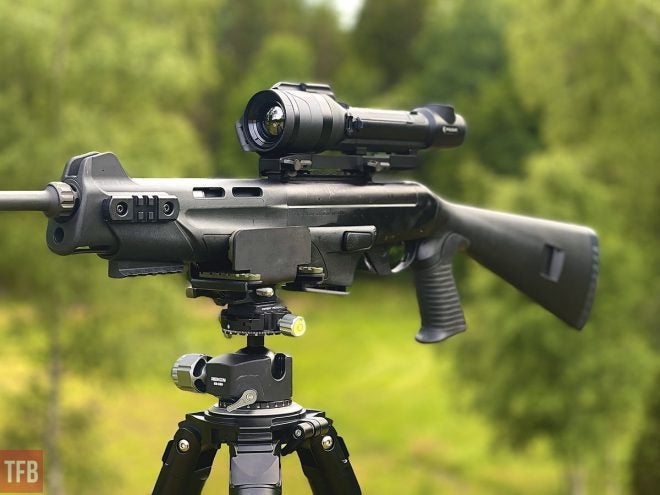
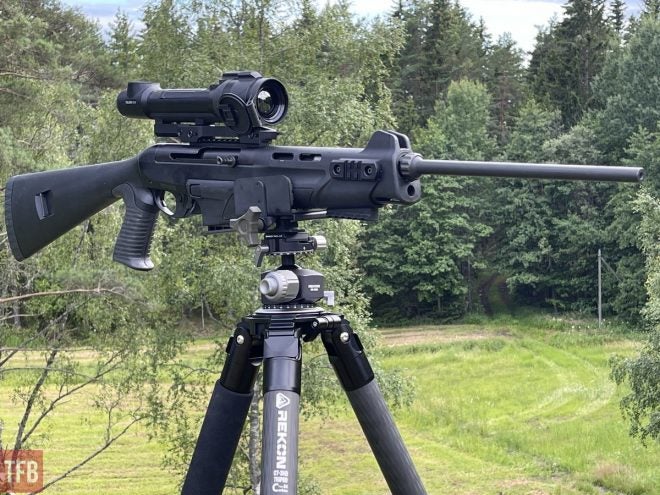
Below: The Pulsar “Battleship”. Mounted on a MOD DOS multi-functional platform you see Talion (left), brand new Pulsar Merger binoculars and Thermion 2 LRF XP50 Pro. This setup makes it easy to evaluate the performance of optics side-by-side at the same time.

Below: Four very powerful sensors. Three thermals (two with laser rangefinders) and Troy the dog’s unbeatable nose.
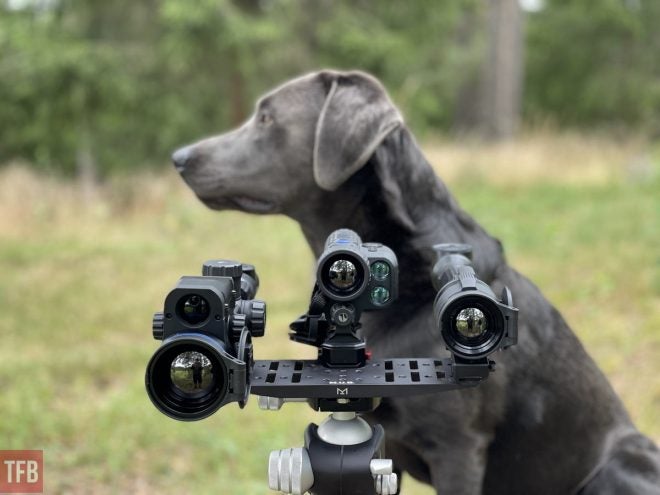
When the moisture rises the tough gets going. At no point did I have any issues with the Talion freezing or behaving oddly.
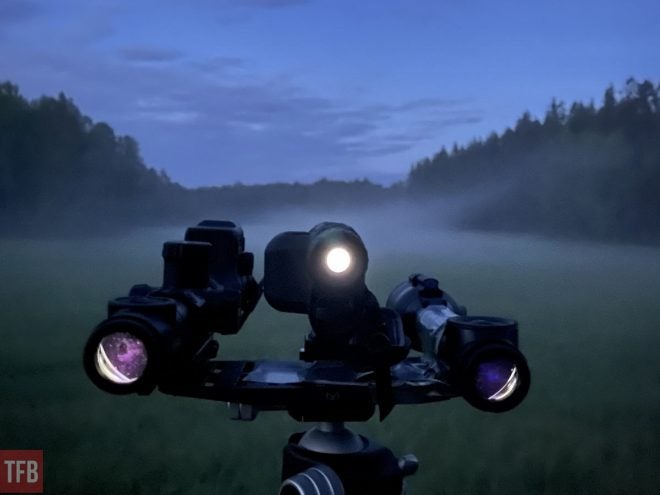
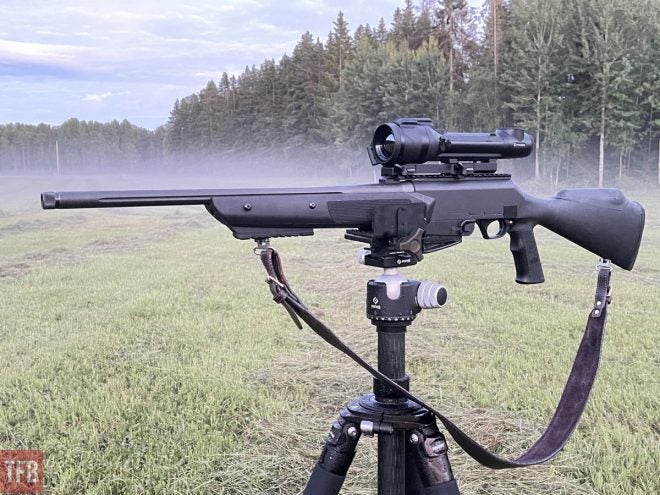
Below: Browning BAR Match with Talion XQ38. Camouflage from Concamo, which you can read more about in an upcoming review. Everything is sitting on a carbon fiber tripod from Rekon Outdoor Gear and a PIG saddle from Shadow Tech. A huge thanks to Scott Country International for helping me out with the tripod and the saddle.
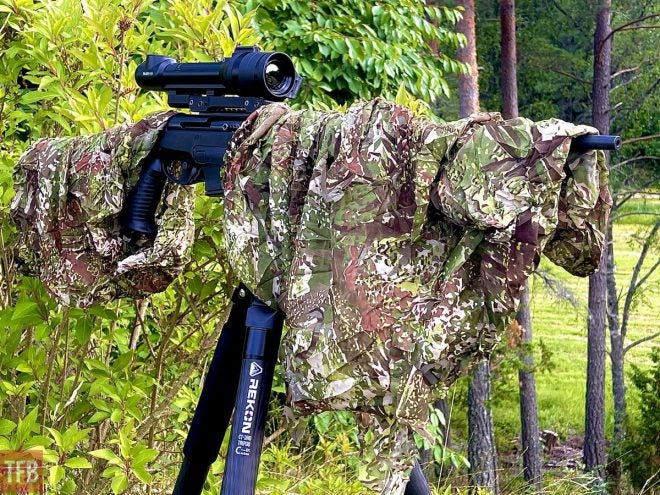
Features
There’s not really room to describe all of the features in detail, but here’s a shortlist: 384×288 Microbolometer Resolution, 2.5-10x magnification with smooth or fixed zooming, 1475 yard detection range, waterproof, IPX7 rated housing, 9-hour battery life (claimed, but seems very close to reality), photo and video (including audio if you like) recording, 10 reticles in 9 colors with 5 shooting profiles and 50 zeroing distances, 8 color palettes, 3 sensitivity levels, Picture-in-Picture mode. There’s also Wi-Fi connectivity with the Stream Vision 2 App where you can upload your material to the cloud and potentially upgrade the firmware in the future.

There are several mounting options for the Talion, but as you may have noticed your ordinary scope rings will not work at all. The one in the pictures is the Pulsar Weaver USQD (p/n 79202). You can find the options from Pulsar here: https://www.pulsar-nv.com/glo/products/33/accessories/rifle-mounts/
The Pulsar Talion is made in Lithuania (Europe). The thermal sensor is made in France. If you’re concerned about devices made in China this would be an option.

The price level seems to be in the region of $2,499 in the USA, and similar in the EU.
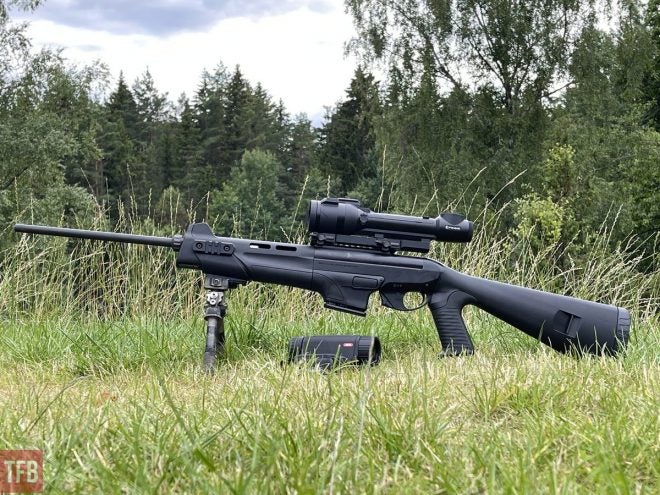
Conclusion – Pulsar Talion XQ38
If you are looking for an all-around thermal riflescope with a tempting price, the Pulsar Talion XQ38 is probably the one for you. I always encourage people to do their own side-by-side tests and make up their own minds, but it may be difficult as various dealers rather sell than stock their inventory. The base magnification of 2.5x will work great on wild boar and some varmint hunting, and the ergonomics will work on virtually any kind of rifle. The features and possibilities to customize the image are almost too many to list, but you could just push the on button and leave it at that if you liked.
Below: You would perhaps think this image was provided by Pulsar, but it’s taken by the author at about 30 meters. There’s a longer video here.
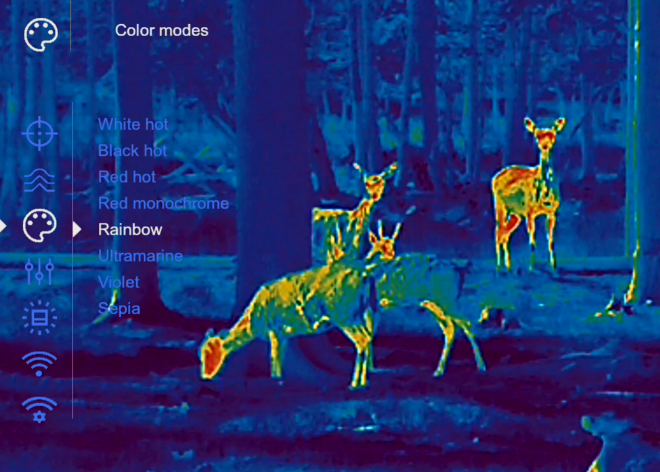
I’ve already told you about most of the features and my only issues are very minor. The hinged lens cap opens itself from time to time (probably from hitting something) and the rubber protection for the USB port likes to stay open most of the time. Other than that, you’re good to go.
If you want a better thermal image there will soon be a Talion XG35 with a 640×480 @ 12 µm (NETD <40 mK) thermal sensor, but it will also push the price point up (unknown at the time). Stay tuned for more reviews of thermals here at TFB. For instance, very soon there will be a TFB review of the Pulsar Thermion 2 LRF XP50 Pro.
You can find a direct link to Pulsar here: https://www.pulsar-nv.com/glo/products/33/thermal-imaging-riflescopes/talion/
We are committed to finding, researching, and recommending the best products. We earn commissions from purchases you make using the retail links in our product reviews. Learn more about how this works.
 Your Privacy Choices
Your Privacy Choices
